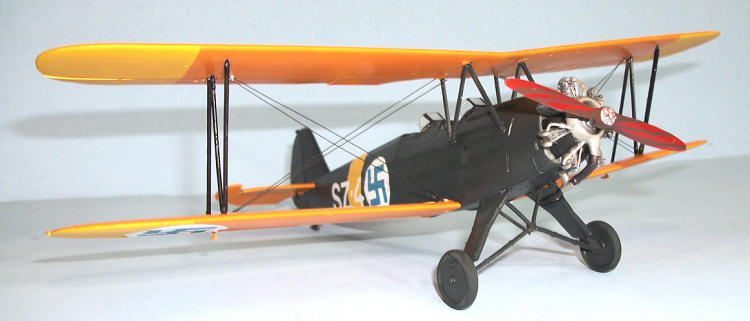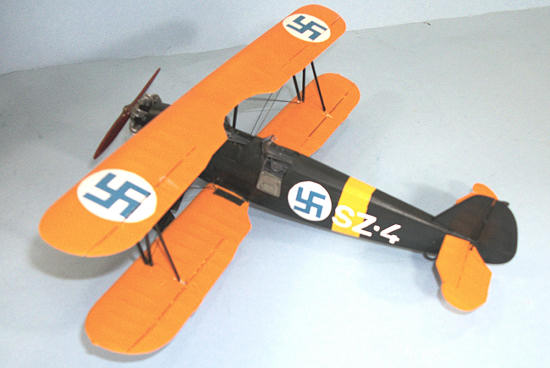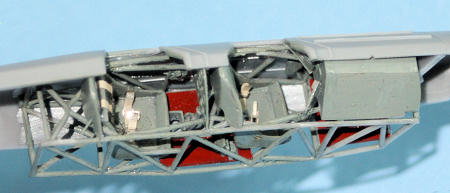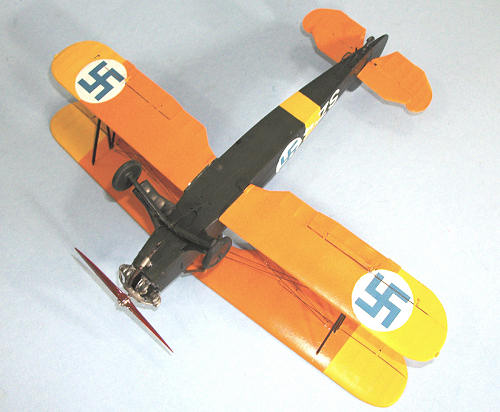
| KIT #: | ? |
| PRICE: | $150.00 or so MSRP (See Silver Wings website. No URL provided) |
| DECALS: | None provided. Paint masks for two aircraft. |
| REVIEWER: | Tom Cleaver |
| NOTES: | Resin kit |

| HISTORY |
Focke-Wulf was founded in 1929, producing several
commercially-unsuccessful designs and being virtually unknown outside
The Fw-44 prototype appeared in June 1932, and made its
first flight in August, with Gerd Achgelis at the controls. Powered by a
140 h.p. Siemens Sh.14a radial engine, the Fw-44 was a single bay biplane with a
welded steel fabric covered fuselage; the wings were wooden with fabric
covering. The flight
characteristics were improved after an extensive flight test program by
Professor Kurt Tank, who had joined Focke-Wulf in 1931 from Willy
Messerschmitt’s Bayerishe Flugzeug Werke.
 Tank
took over the design and flight test departments when Heinrich Focke became
pre‑occupied with his rotary wing development.
Tank
took over the design and flight test departments when Heinrich Focke became
pre‑occupied with his rotary wing development.
The Stieglitz had fine harmony of control, great maneuverability
and full aerobatic capabilities, and became known as an outstanding aerobatic
mount, particularly when flown by Gerd Achgelis, Emil Kropf and Ernest Udet.
At the first ever World Aerobatic Championship, organized by the Aero
Club de France in Vincennes, near Paris, Gerd Achgelis finished a respectable
third with his Fw-44 behind Michel Detroyat and Gerhard Fieseler.
Otto von Hagenburg won the World Aerobatics Championship in 1936 flying a
Fw-44.
With this record, the Fw-44 was successfully marketed internationally as
a primary trainer, and was exported to Bolivia, Chile, China, Czechoslovakia,
Finland, Romania, Switzerland and Turkey, with licence production in Argentina,
Austria, Brazil, Bulgaria, and Sweden.
The Fw-44 was the Luftwaffe’s most common primary trainer during the
Second World War and was for the Germans what the Stearman PT-13/17 series was
for the
85 Fw-44J Stieglitz aircraft were produced or assembled from German parts
by ASJA - the forerunner of SAAB - under license as the SK12 for Flygvapnet
and delivered between 1939-43. The
SK12 was powered by a 7‑cylinder Bramo Siemens Halske 14A radial of 145
h.p., which was manufactured by
BMW Flugmotorenwerke. The Stieglitz was replaced in 1946 as the
standard trainer by the SK25 (Bücker Bestmann), and the SK12s were then used for
liaison, weather flying, etc. and of course training. When the last Air Force
SK12 was written off in 1968, many were still in use by flying clubs, where it
was a popular tug for sailplanes, or were flown by private owners. These SK12s
form the majority of the still-existant Fw-44s, along with a few survivors
produced in
35 Aero-built Fw-44Js were purchased by the Finnish Air Force in 1940.
They served as the main primary trainer of the Finnish Air Force until
1961. Several of these are also
still in existence and flying in
 There are three SK12s in the
There are three SK12s in the
| THE KIT |
The only other kit of a Fw-44 is a limited-run 1/72 plastic kit by Huma, which “needs work” to be brought up to an acceptable standard. I have to say I do not know what possessed Wojciech Kulakowski to create this model, which is the second 1/32 kit released by his company Silver Wings (he is also the designer of all the kits released by Montex), but the result is probably the most beautiful all-resin kit I have ever seen. The design is flawless, the assembly is easy, the parts want to fit. The kit is truly the “Tamiya kit” of all-resin kits. The kit comes with a complete interior, though it lacks seatbelts. Markings for two different Luftwaffe Fw-44C trainers are provided with masks.
| CONSTRUCTION |
 Construction definitely starts with the cockpit.
I painted everything in RLM Grey, then proceeded to follow the
instructions for assembly. I used
Eduard photoetch Luftwaffe
Construction definitely starts with the cockpit.
I painted everything in RLM Grey, then proceeded to follow the
instructions for assembly. I used
Eduard photoetch Luftwaffe
| COLORS & MARKINGS |

| FINAL CONSTRUCTION |
| CONCLUSIONS |
 A beautiful kit of an airplane I have personal fond memories of.
This kit is so good, I would recommend it to any intermediate/advanced
modeler as both a first all-resin kit and a first biplane model. There are an
endless number of markings possibilities, given all the air forces the
Stieglitz served with, and all the various civil markings these airplanes
have carried over the past 70 years.
For the overall superb quality of the model in both design and
production, it is a bargain at this price.
It’s highly unlikely anyone else will ever do a kit of this airplane.
Highly recommended.
A beautiful kit of an airplane I have personal fond memories of.
This kit is so good, I would recommend it to any intermediate/advanced
modeler as both a first all-resin kit and a first biplane model. There are an
endless number of markings possibilities, given all the air forces the
Stieglitz served with, and all the various civil markings these airplanes
have carried over the past 70 years.
For the overall superb quality of the model in both design and
production, it is a bargain at this price.
It’s highly unlikely anyone else will ever do a kit of this airplane.
Highly recommended.
Review kit courtesy of Silver Wings.
April 2010
Copyright ModelingMadness.com. All rights reserved. No reproduction in part or in whole without express permission.
If you would like your product reviewed fairly and quickly, please contact the editor or see other details in the Note to Contributors.
Back to the Review Index Page 2022